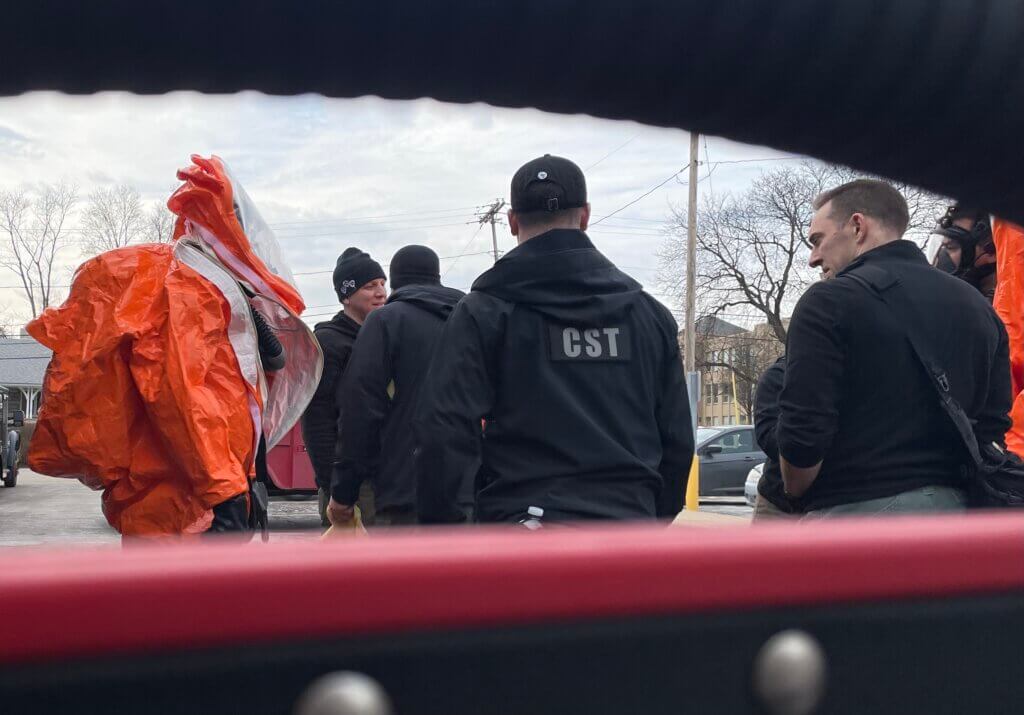National Guardsmen have attended New Mexico’s Balloon Festival, several NASCAR races, the Kentucky Derby and numerous Super Bowls in the past 25 years. But they didn’t go for fun, fancy clothes or fast cars.
Instead, the Guard’s Weapons of Mass Destruction-Civil Support Teams, or WMD-CSTs, supported civilian authorities regarding chemical, biological, radiological or nuclear (CBRN) concerns at these events.
The teams often respond to urgent threats like a February train derailment in East Palestine, Ohio, or a 2014 chemical spill into a water supply near Charleston, West Virginia.
“They are the absolute tip of the spear,” Kentucky National Guard Lt. Col. Joe Fontanez said of each team’s survey section. “Those are the guys that are getting suited up in hazmat suits and go downrange and ultimately bring back samples.”
His teammates complete 10 to 12 field training exercises a year after several weeks of baseline and specialized training, Fontanez said. Then, the soldiers and airmen have the situational awareness and skill with tools that detect CBRN threats at the Kentucky Derby, Super Bowl and similar events.
The CBRN officer who commands the Kentucky Air National Guard’s 41st WMD-CST said 18 Army National Guardsmen and four Air National Guardsmen form the team. They operate in sections including survey, command, operations, logistics/administration, communications and medical/analytical.
Tennessee National Guard Lt. Col. Bobby Rominger said WMD-CST soldiers and airmen complement the work of local emergency management agencies or federal authorities. The infantry officer and branch qualified chemical officer commands Tennessee’s team.
“We go out and try to work as much as we can with local fire department, hazmat teams and bomb techs to talk about how we use our sensors,” he said. “You want the relationship, you want to meet the people and have the relationships before the incidents happen.”
Active-duty, full-time teams in all 50 states respond to the request of local, state or federal authorities for aid related to CBRN threats.
RELATED: Operation Deep Freeze serves as bucket-list item for Wyoming flight nurse
Once on site, many of the teams also use robots with sensors, cameras and other tools for CBRN risk assessment. Another contribution teams can make is supplying a communications platform when authorities lose power during a crisis, Rominger said.
Team members must complete an eight-week civil support skills course at Fort Leonard Wood, Missouri, according to National Guard Bureau spokesman Lt. Col. Chris Mitchell.
Then the National Guardsmen are hazmat-technician qualified and obligated to active-duty service for 36 months, he added.
That training comes after a selection process as rigorous as any incentivized recruiting program like Army Ranger School or special operations, Mitchell said. The challenge and the value of CSTs motivated Fontanez when the Kentucky commander heard what the teams do.
“It’s really something that inspired me,” Fontanez said. “It’s just another way for us to be out there and help good people and protect folks against bad actors and bad things that are out there.”
Rominger also said that a team role can create a career path for guardsmen seeking civilian work with emergency management agencies.
“There’s a lot of very good quality training,” Rominger said. “Positions on the team are very sought after.”
More than 20 years ago, Maj. Allen Autrey, of the Minnesota National Guard, made the opposite career choice: CBRN threats motivated him to leave his civilian job as an emergency room doctor and ambulance services director to become a soldier.
The critical care physician was 45 years old in December 2001 when his colleagues participated in a training exercise that simulated the release of a nerve agent on medical staff.
“My EMS personnel went to an exercise right after 9/11 and they were basically all killed by a hypothetical nerve agent,” Autrey said. “I was pretty alarmed by how badly the community was prepared for something like that.”
After that, he left his medical practice for the Guard.
Autrey wasn’t the only one getting prepared for CBRN dangers. A 1995 sarin attack in Tokyo motivated federal leaders to assess America’s capability for thwarting a chemical attack, Mitchell said.
A few years later, Mitchell said the Secretary of the Army and Congress solidified the WMD-CST program within the National Guard. He said the first 10 teams began in 1999. The next 47 teams stood up between 1999 and 2007.
In 2007, the team’s mission statement expanded to include natural and manmade disasters, Mitchell said. Last year, there were 1,375 deployments of WMD-CSTs around the U.S.
“This program is incredibly important for protection of our civilians,” Autrey said. “It’s at the heart of the mission statement of the National Guard.”
That’s why he’s convinced WMD-CSTs are great opportunities for mid-level medical providers to do a tremendous service to the American people. Now, he strongly recommends that men or women who are physician assistants, nurse practitioners or physicians join a team.
“This is an extremely exciting role of the National Guard,” Autrey said. “It’s been a wild ride. I have been eternally grateful that I had the opportunity to capstone my medical career with this activity.”

